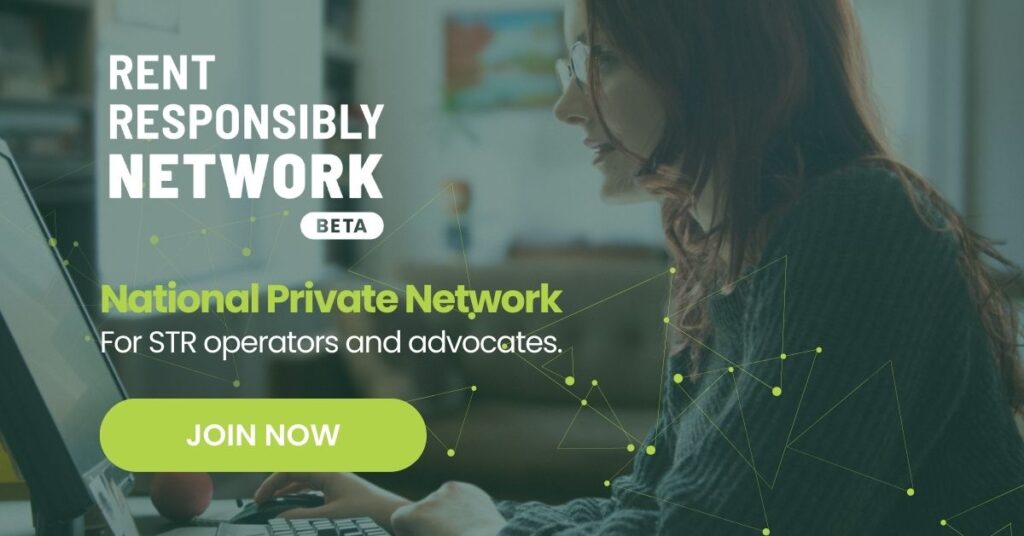
Public speaking and communication skills are an essential part of short-term rental advocacy. These skills help advocates effectively tell their story and communicate short-term rentals’ value to a community, especially during high-stakes regulatory discussions at the City Council or the County Commission. These skills are also transferable to speaking or networking at conferences, talking to the media or on a podcast, and one-on-one business negotiations.
In this webinar, Amber Erickson-Hurdle, an expert in branding and leadership, shared actionable tips and techniques to transform your speaking, presenting, communication skills, and powers of persuasion.
Here are four takeaways From Nervous to Natural: Unleash Your Inner Speaker, including Amber’s insights and experiences from her background in hospitality and politics and her role as keynote speaker, author, and host of the Bombshell Business Podcast with Amber Hurdle.
To watch the entire webinar, join or log into the RR Network BETA and head to the Replays & Downloads library.

- Establish credibility and authority.
Craft an introduction
Establish credibility with your audience early on by crafting an introduction tailored to them and the topic. An introduction sets you up for success and sparks curiosity in your audience.
“If I’m going to go speak in the construction industry, … I’m not going to talk about the things that I’ve done in hospitality,” Amber said.
Cite statistics
Then, demonstrate your credibility and subject matter authority by citing current statistics and research. “This is really important when it comes to advocacy efforts, especially because people get really emotional about those things,” Amber said. “It’s good for you to come back with facts like, ‘I know you feel this way, but the facts are this. This is how much commerce we bring to the area. This is how many people come to the area because of travel and tourism. … These people come to our town; you and all of your small businesses make money.’”
Agree on facts
Establish a foundation of facts on which everyone can agree. For example, refer to a community’s future use plan, city charter, ordinance language, or previous City Council meeting minutes.
“We’ve already decided this is true. Now we can layer onto that the more persuasive arguments,” Amber said.
Bring up legal precedents and expert opinions
Reference any legal precedents and expert opinions that add credibility to your position.
“This happens all the time in law and in the courtroom; it also can happen whether you’re speaking at a conference on a podcast, dealing with advocacy efforts, or initiating advocacy efforts representing our industry,” Amber said.
Example: “A Honolulu federal judge has permanently blocked a portion of a Honolulu short-term rental ordinance that outlawed 30- to 89-day stays on the state’s Oahu island and banned advertisements listing daily rental rates or rates under three months.”
Source: Law360
Share personal experience
Finally, share your personal experience and research in a way relevant to the topic.
Example: Like many women, I needed a more flexible work schedule to earn income for my family while caring for young children. So, I started managing my neighbors’ beach homes and listing them on vacation rental booking sites.
Despite advancements in the workplace, women continue to bear most of the burden of caretaking. Mothers spend twice as much time caring for children as fathers do in the U.S., according to the Pew Research Center. Vacation rental hosting provides a flexible work option conducive to family caregiving and other responsibilities as child care becomes increasingly scarce and expensive.
For more tips on using data to support your presentations, check out the Data-Driven Storytelling for Effective Advocacy replay inside the RR Network.
- Craft powerful content.
To create powerful content, you need to identify your audience’s motivations, your objective, and three key points that both support your objective and speak to your audience. Finally, determine what action you want your audience to take, but beware of making a sales pitch. Most audiences respond better to sharing knowledge and storytelling.
Make your content into a story with a beginning, peak, and end, Amber said. Weave in humor, and when possible, let your audience come into your story.
“Ask the question: Have you ever had one of those nights where you couldn’t sleep? And then one o’clock rolled around, and you thought, well, maybe I’ll get a couple hours, and then two o’clock and three o’clock, and then four o’clock? We’re not sleeping tonight,” Amber said, as an example followed by a pause. “Do you see how that’s different when I let it land and let their brains go and get into their bed where they have that night? Because we’ve all had that night.”
To access Amber’s full presentation and slide deck, including a content outline on pp. 19-22, join or log into the RR Network and head to the Replays & Downloads library.
- Engage and influence your audience.
To influence your audience, you need to know them.
“There’s something different with the mountain towns versus maybe the Outer Banks versus the beach towns versus the STRs in more urban environments. What’s specific to this audience, and then make sure that you show up for that,” she said.
Make your presentation interactive with a poll or something entertaining, and include personal information about yourself that makes your audience more interested in listening to you.
To learn more persuasive delivery techniques you can leverage to influence your audience, go to 29:00 of this recording in the RR Network Replays & Downloads library.
- Calm nerves and exude confidence.
One of the unsettling parts of public speaking is the judgment you might encounter while up on stage. Remember that it’s not about you; it’s about your message, Amber said.
“The minute I step on stage, you’re judging me, what I’m wearing, what I sound like, so let it go,” she advised. “You have to be you, and then let everybody else have their experience of whatever that is; you’re not going to change it. If you let that go, then it can’t get to you.”
To calm your nerves, focus on just one person in your audience. Know your stuff so you are confident in your delivery of facts. Before the presentation, take care of yourself with proper sleep, nutrition, hydration, space, moderate alcohol and caffeine consumption, and groom yourself.
Read more: Find Amber’s answers to some frequently asked questions about public speaking from participants in the webinar.
…




